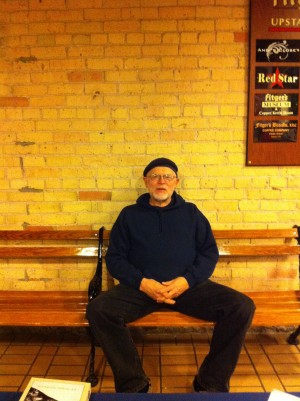
Gerry waiting to buy Laman’s River at Fitger’s.
Some of you have heard the story. But for those who haven’t, I think it merits retelling here, in the last issue of the New World Finn.
Back in 2000, I ”discovered” the story of Olli Kinkkonen, a Finnish dockworker whose mysterious death was postulated to be a despondent suicide by the Duluth police but considered to be an unsolved murder by the Finnish immigrant population of my hometown. As someone who grew up surrounded by Finns, I saw enormous possibility in the story of Kinkkonen’s death. Originally, I’d intended to write a fictionalized account, a faux biography if you will, of the man and his times. Growing up in northeastern Minnesota, rubbing elbows with my Finnish pals, and with familial roots of my own on Minnesota’s Iron Range, I’d always been interested in immigrant history and Finnish immigrant history in particular. What prompted those crazy Finns to farm this godforsaken land? I’d grown up calling the descendents of the Finnish immigrants who built their sturdy log saunas, barns, and homes “Finnish rock farmers”; a pejorative grounded in the mounds of stones one finds on every forty acre Finnish farmstead in my neck of the woods. But as I explored the circumstances surrounding Olli Kinkkonen’s demise, I came to realize that, in exploring the man’s death, I was uncovering a bigger story, a story in which the unfortunate dockworker would play, in the end, only a minor role.
Understand: even after I decided to focus on fictional characters, relegating Olli to a peripheral stage in the grander story I envisioned, I went to work researching and writing the history of the Finns in North America with trepidation. I knew from my interactions with Finnish friends and their parents and grandparents that Finnish Americans are, by and large, circumspect of outsiders trying to define their history. I also knew that there was a retired Finnish American member of the Duluth Police Department researching Kinkkonen’s story with an eye towards writing a book. Both my ethnicity and time appeared to be against my creating a fictional re-telling of Olli Kinkkonen’s life that would be commercially viable. And yet, I couldn’t resist. I plunged ahead.
Suomalaiset: People of the Marsh emerged four years later. By the time my novel about Olli’s death, Finnish immigration, the Great War, the Cloquet Fire, and the Influenza outbreak of 1918 was published, I was exhausted and fearful: fearful that Finnish American and Finnish Canadian readers would pillory me at the dock of public scrutiny. Against this backdrop of paranoia, I set out to give interviews and explain Olli’s story to the world. It was as a guest on the Duke Skorich Radio Show on KUWS that I had my first encounter with the subject of this essay.
Duke’s show was an hour-long talkfest broadcast from a cramped little studio on the University of Wisconsin-Superior campus. Duke, his co-host, Patty McNulty, and the show’s producer, the late Mike Simonson, welcomed me and made me feel at home. Adding to my comfort level was the fact that the show’s format that day didn’t allow for listener calls. And yet, near the end of the hour, a listener did call in, wanting to quiz me about the research behind Suomalaiset. My immediate reaction was, “Oh, oh, a pissed off Finn is calling to tell me what I got wrong. Duke handed me the caller’s name and telephone number but spared me any on-air embarrassment. I said I’d call after the show. It was a lie. I never intended to return the call. But for some reason, on the drive home, I felt compelled to find a pay phone and dial the number Duke had written down. My decision to face the music that day was the best decision I’ve ever made as a writer. The man on the other end of that fateful conversation was Gerry Henkel. Turns out, Gerry was so intrigued by a non-Finn’s interest in Kinkkonen’s tragic story that he wanted a copy of Suomalaiset to review for the New World Finn, a newspaper he edited. I sent a review copy, Gerry read the book and became the most vocal proponent of my writing I’ve ever been blessed to know. He was better than his word: Not only was Suomalaiset given a glowing review in this newspaper, Gerry added a full-page author interview to accompany the review. He also put me in touch with the paper’s publisher, Ivy Nevala, who added Suomalaiset to the newspaper’s stock of literature available for purchase through the New World Finn.
Had I not returned that telephone call, Suomalaiset would likely have sold a few hundred copies. Instead, the novel became my best selling book and has been read, critiqued, and enjoyed by folks from Vancouver to Helsinki. But there’s more.
Gerry introduced me to members of the Finnish American, Finnish Canadian, and Finnish communities at ethnic festivals from Thunder Bay, to Duluth, to Marquette, and beyond. He was my proverbial “foot in the door” in terms of gaining respectability and authority as a non-Finn writing about the Finns. His connections took me to Turku where I gave a presentation at the Institute of Migration. We’ve become good friends, and, truth be told, he’s been a promoter of all my work, including books like Laman’s River, a murder mystery that has nothing to do with the Finns. And then there is this: When I was at a loss as to where to head next with my very eclectic and diverse fiction writing, Gerry suggested that a sequel lurked within the pages of Suomalaiset. Smitten with the character Elin Gustafson, a newspaper reporter and modern woman who is a central figure in Suomalaiset, Gerry convinced me that Elin had more to say. And so, Sukulaiset: The Kindred, my latest historical novel, was born.
Here’s the level of Gerry’s unselfishness, his drive to help others succeed in telling the story of the Finns. Just prior to a recent book launch of Sukulaiset at the Fitger’s Theater in Duluth, Gerry asked if his friend, internationally known musician, actress, and personality, Ulla Souko, could read passages from Sukulaiset during our conversation in front of the audience. Gerry also suggested that I ask Finnish American singer/songwriter, Diane Jarvi to provide music for the event. Those two women made October 9, 2014 the most memorable evening of any I’ve spent as an author.
After this issue is “put to bed”, the New World Finn will sleep for eternity. I’ll miss writing book reviews for this quirky little paper. I’ll miss reaching into my rural mailbox to withdraw each crisp, new copy of this unique publication. I’ll miss reading intelligent, probing, enlightening articles, essays, stories, poems, and reviews. But I am left with this: I’ll always cherish my friendship with Gerry Henkel, the man who started it all for me amongst the Finns.
Kiitos, ystävä.
Mark


